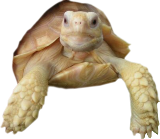
Riparian Farms

Care Sheet: Red Foot & Yellow Foot
Red-foot Tortoise (Geochelone carbonaria) and yellow-foot tortoise (Geochelone denticulata) are medium to large South American Species. The red-foot Tortoises grows from 12 to 18 inches with a dwarf race (the cherry-head) that only gets 7 to 10 inches. The yellow-foot tortoise grows from 14 to 20 inches with reports of over 32 inches and 200 pounds. The care of both these species is very similar except that the yellow-foot tortoise requires higher humidity levels than the red-foot tortoise. The red-foot Tortoise seems to be a little hardier than the yellow-foot tortoise (it can take a little more cold, higher temperatures, and a little more neglect).
When you receive your tortoise soak it in shallow lukewarm water for about 20 minutes. Hatchling tortoises should be housed indoors. They can be put outside to receive natural sunlight, but should be watched and be able to get out of the sun when they get warm (if not they may become over heated and die). 6-inch tortoises can be kept outside during warm months when night temperatures are above 65 degrees and days are sunny. They cannot endure cool temperatures and don't hibernate. Larger tortoises can be housed in greenhouses, or in warm rooms with the tortoise confined in a large sturdy pen.
Hatchling tortoises can be maintained in a large glass aquarium, or a large plastic box such as a sweater box. The aquarium should be lighted with a good UL bulb and there should be a basking light on one side of the aquarium or box. The temperature at night should be above 65 degrees and days 80-85 degrees. The tortoises require a basking light so they can elevate their body temperature to 85 to 90 degrees, which aid in digestion. Humidity levels for red-foots should be 50% to 80% and yellow-foots 60% to 90%.
Both species are opportunistic feeders (meaning they eat much of what they can find during their wondering). They are mainly herbivores but do eat a little bit of meat in the wild. Larger tortoises can be maintained on lawns and will eat grass, leaves, and fallen fruit. They don't need a lot of fruit. If natural grass and leaves are not available adults can be fed dark green vegetables and commercial tortoise diets. They should always have water available or can be soaked in a shallow pan of water every day especially if temperatures are high. They should always have plenty of shade available so they can get out of direct sun when they desire. A hide box or turtle house is also recommended.
Hatchling tortoises should be fed daily. A diet of chopped greens (kale, endive, mustard, dandelions, etc.) and/or a commercial tortoise diet (15% to 18% protein) should be fed to the tortoises. They should be soaked in shallow lukewarm water every day. Do not keep them on sand. Slightly moist peat moss or moist coconut husk is an ideal substrate that will help elevate humidity. It must be changed regularly to prevent bacteria and mold build up. It is best not to feed the tortoises on the peat moss. They seem to be able to pass the peat moss safely however if eaten in small quantities. If your tortoise is kept warm fed and watered regularly, and given adequate room it should live for years. Small tortoises can grow about 2 inches per year.